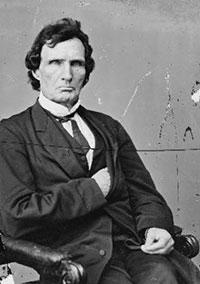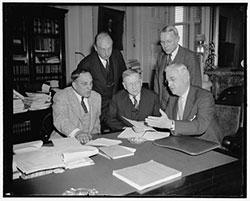History
"No money shall be drawn from the treasury but in consequence of the appropriations made by law; and a regular statement of account of receipts and expenditures of all public money shall be published from time to time." -U.S. Constitution, Article I, Section 9, Clause 7
The U.S. Constitution grants Congress sole power of the purse. Congress has carried out this duty since the birth of the Republic; however over time the manner in which Congress has carried out this duty has evolved.
In 1789, a single appropriations bill, totaling $639,000, supported all of our young nation's needs. At that time, the appropriations function was the responsibility of the Committee on Ways and Means, which Congress established that same year.

By 1860, largely due to the massive cost of the Civil War, federal spending jumped from an average of $60 million a year during peacetime to a high of $1.3 billion in fiscal year 1865. Faced with this increase, and the workload that came with it, on March 2, 1865, the House of Representatives separated appropriating duties from the Ways and Means Committee and assigned them to the new Committee on Appropriations.
The Committee on Appropriations – originally comprised of six Republicans and three Democrats – was appointed its first members on December 11, 1865. Thaddeus Stevens (Pictured Right) of Pennsylvania was the first chair. The Committee took responsibility for ten bills, not including deficiency bills, and first reported general appropriations bills for fiscal year 1867, totaling $357 million.
During the late 1800s and early 1900s, authorization committees began to exert authority over Appropriations Committee duties. This decentralization of appropriations authority is often blamed for the growth in federal spending during this period. Following the outbreak of World War I and a new peak for fiscal spending of $18.5 million in 1919, Congress recognized the need to centralize appropriations authority in order to manage debt after the war. In June 1920, the House passed Resolution 324 re-concentrating control to the Committee on Appropriations and also expanding committee membership from the then 21 to 35.
The following year, in 1921, the Budget and Accounting Act created the Bureau of the Budget, (the forerunner of the current Office of Management and Budget) requiring, for the first time, the President to submit a budget request to Congress.
While the close of the war in Europe caused a precipitous decline in spending – falling to $3 billion in 1927 – the dual challenge of the Great Depression and World War II and America's rise on the global stage would drastically alter the course of Federal spending and the duties of the committee.

By 1940, as the New Deal helped drag America out of the depths of the Great Depression, federal spending increased to $14 billion. The defeat of Nazi Germany and Imperial Japan would extract an even greater financial cost. In 1943 some $143.8 billion was spent. After World War II, spending declined to the $30 billion range and then once again increased to $91.1 billion in 1951 during America's involvement in the Korean War. By 1951, the Committee had 50 members.
The 1960s brought significant changes as President Johnson's "Great Society" programs expanded aid to public education, invested in healthcare research, attacked poverty, and supported natural resource conservation. While the Vietnam War curtailed the Great Society programs, President Nixon expanded upon many of them, particularly in the area of environmental protection.
By the early 1970s, battles between the Nixon Administration and Congress helped spur passage of the Congress Budget and Impoundment Control Act of 1974, which established the Congressional Budget Office and required Congress to pass an annual budget resolution intended to better reconcile revenue and spending. To accomplish this, the Act also established permanent standing budget committees in both chambers with the primary task of drafting a concurrent resolution to be voted on by the House.
In 2007, David Obey became the chairman of the Appropriations Committee for the second time after a brief chairmanship in 1994. The number of subcommittees was moved from 10 to 12 in order to mirror similar subcommittee structures between the House and the Senate. In 2011, Norm Dicks became Ranking Member when Republicans won the House majority, and Nita Lowey became the first woman to lead either party on the Committee in 2013.
Today, in the 118th Congress, the Appropriations Committee is chaired by Chairwoman Kay Granger and the Ranking Member is Rosa L. DeLauro.
Additional Resources
House Committee Print: "A Concise History of the House Appropriations Committee, 1865-PRESENT"
